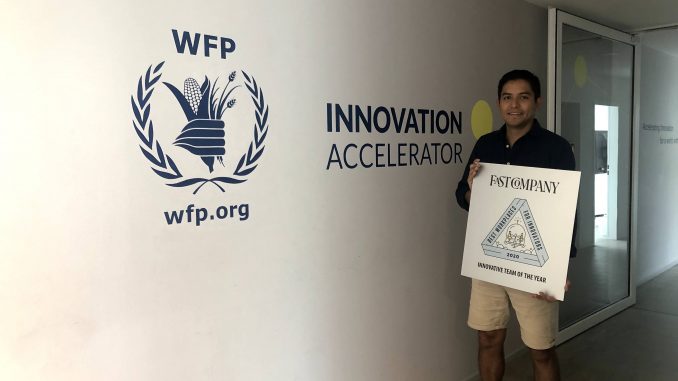

Hi everyone and welcome to the Alumni Webinar Series at ESMT Berlin. I’m Chelsea Steensen, the alumni relations manager and today I’m joined by Alex Lozán, who will be chatting with us about his experience and knowledge gained while working in social entrepreneurship with the United Nations.
So, Alex, can you first just tell us a bit about yourself and your ESMT journey?
Alex: Sure Chelsea, thank you for having me here. I’m very happy to join the webinar. I’m Alex Lozán as said, I’m originally from Peru. I did my MBA with ESMT in 2016. I grew up in Peru in six cities across coasts, mountains, and the Amazon.
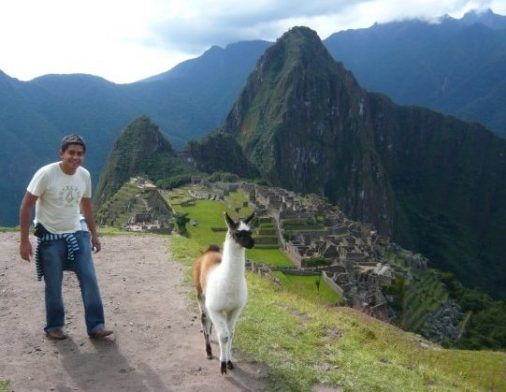
Because of my parents’ jobs, I was very lucky when I was a child as I could experience different cultures, nature, and meet new people. Every two to three years we had to move and meet new friends and teachers and experience new flavors, markets, and playgrounds. So, I grew up already on the road, but then we moved to Lima when I was about to finish high school, start university, and work there.
As you might know, Peru is still a very centralized country so there are more opportunities for education and work in the capital, Lima. So, we moved there for that reason, and I did my bachelor’s degree in business administration. It was not the first choice I had in mind back then. As a kid, I wanted to be an engineer. I liked to build stuff, create, design.
I looked at different careers and discovered business administration and I liked it. It resonated with me because I saw that with that, I could create value, put it in the market, and make it useful for other people and it benefits society, nature, and people in a more holistic view. So, I went for it.
I studied at the Universidad Pacifico in Lima, one of the most prestigious universities in the country and I started when I was 16.
Chelsea: Oh wow.
Alex: Yes, I was one of the youngest in the class and graduated when I was 21. Just after a semester of an exchange program in Hungary, I did an optional semester as an exchange student in Budapest at the Corvinus University of Budapest. That was an amazing, wonderful experience that opened my eyes and mind to the world and to an international career.
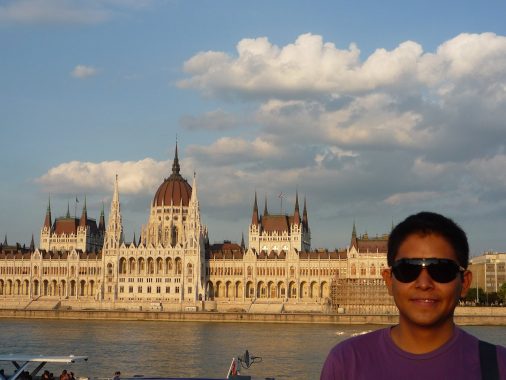
That is a bit of my origins. I shared this because this shaped a lot of who I am now and what I do. I worked for 10 years in the private sector. It’s funny that the very first job I had was during university doing an internship in the Amazon region with an NGO supporting farmers, small-holder farmers in the Amazon to create or improve their business models, to improve their livelihoods and income.
That was my very first experience but then I went into the private sector for 10 years. Always working on entrepreneurial projects. First launching a brand of hardware in Peru, nationwide. Then I moved to Hungary again. I wanted to have work experience in Europe, so I worked there for three years expanding a commercial bank’s service to Latin America.
Then I went back to Peru after a stopover of a year in Colombia. I worked in Peru for three years scaling up a food production plant. This was very entrepreneurial and gave me the opportunity to develop and collect leadership and managerial experience, which helped me realize that I wanted and needed to pursue the next step in my career, which was doing an MBA. This experience in Peru, particularly leading a scale-up, a company that started as a kitchen and then developed into a factory, helped me focus and narrow down what specific knowledge and skills I was missing or wanted to learn as a manager and that brought me to Berlin, Germany, to study the Full-time MBA at ESMT in 2016.
Chelsea: That sounds great. I would love to know a little bit more about what you’re doing now since graduation and how you were able to find yourself from an MBA at ESMT Berlin all the way to the United Nations.
Alex: Sure. So, for me, the ESMT experience began before deciding to apply to ESMT. For me, it was a journey. It was not just an MBA of one year, and that it will end there, just after 12 months. It was a year of thought, a block of three years. That’s how I’ve been living in my experience in different countries, in blocks of three years. As I mentioned before, three years in Peru, three years in Hungary, three years in Peru again. There are no hard cuts, it’s just giving certain planning time to think ahead.
So, for me, ESMT was a three-year journey more or less in the end. It was more that the first year was the program itself, which was very intense, from 9:00 a.m. to 5:00 p.m., the classes, then a few hours of work, teamwork, assignments, readings, case studies for the next day. So, it was from nine to nine, at least sometimes until 11. In a very intensive way.
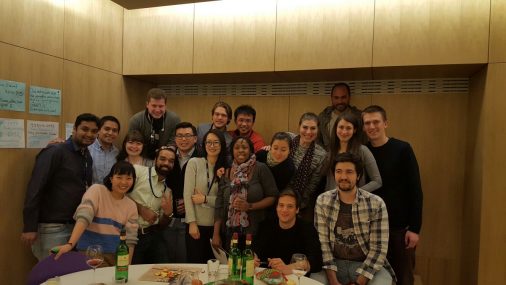
You know, we were interacting often, in a diverse class with 64 classmates from 40 countries. We got some very rich experiences. The curriculum over the year was diverse, it went from managerial skills, design thinking, strategic training, to more practical exercises. I loved the work around innovation management, exercises on entrepreneurship, tools, and methodologies. We called that the entrepreneurship toolbox. This empowered me with knowledge, skills, and experience. In the meantime, in my free time out of class, I liked to explore the city.
Berlin is one of the most important hubs in Europe for innovation, entrepreneurship, and social entrepreneurship. The social impact community is quite big. It is one of the most important in Europe. So, I always tried to use that free time to connect with people in the city. Every day, there was an event or a webinar (in-person back then) to connect, network, learn, and just mingle with the community. I took every chance I could to explore.
So that year was very focused on developing skills, experience, knowledge, and the international field seminar. It was a very rich experience. ESMT provided students with the opportunity to gain exposure and experience with social impact. That was one of the reasons why I joined ESMT.
I had known about the Responsible Leadership Fellowship before applying to ESMT. I kind of knew already where I was going to go, and I just confirmed that during the MBA. I did my Responsible Leadership Fellowship in Cape Town, in South Africa, in a business school that provides degrees to students that come from previously disadvantaged communities.
In South Africa, access to education has been limited, especially for certain groups or ethnicities. So, this university gives scholarships and degrees to students from these communities. Part of their business model is to onboard volunteer lecturers, national and international, to contribute to the curriculum and teach students. I was one of them. I was teaching entrepreneurship and business management to students from the first year to the last year of the undergraduate program. I also helped organize a consulting program for micro-entrepreneurs in South Africa, in cooperation with a university in the US that was visiting the university every semester.
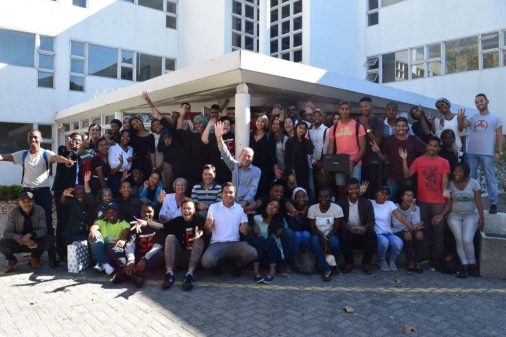
In South Africa, I learned two things, well many things, but the ones I want to mention today for the topic are first, the concept, the definition, of social entrepreneurship. Working with students, working with this university that came from the US, teaching entrepreneurship, focusing on solving social problems, and measuring impact and financial sustainability, made me realize that there was a name for what I wanted to do or what I was already doing: social entrepreneurship. It gave me that direction to where I wanted to go. When I came back to Germany, I focused on getting more immersed in the social entrepreneurship world.
The second thing I learned, was from the students. One can focus on the social problem and the potential impact, one can create to help society, nature, people, and then build the business model that will make the impact become financially sustainable. I learned from the students that this is possible and that it should be the way of working.
I was happily surprised many times when I heard from students who would come to me to pitch an idea that was fully focused on the impact, the potential impact they could create. They would sometimes forget what business they would make around it or if they would be able to make money out of it. But they would not worry about it. They just wanted it to solve a problem.
So, my role there was to tell them it is great and perfect that you’re focusing on the social problem, but you must also find the business around it, or otherwise, it would be a charity program or philanthropy program that might not succeed or continue in the long-term.
I brought this learning with me to Europe to expand and share it with others. Interestingly, I found the same experience, the same pitches from older people, more mature, more prepared professionals in Europe. People who were focusing on social problems but not on the financial sustainability. And that’s actually what I do now. I help social entrepreneurs build from design, the business models that will create value for people, planet, profit, and build a sustainable business model or financial business model to sustain it.
Chelsea: I think the one main point that you kept emphasizing is sustainability. So, I am curious to know, can sustainability work its way into a societal norm, such as feeding the hungry, and what are some major challenges that you can see with regards to making something sustainable in today’s world?
Alex: Sustainability is particularly important, big word and topic, and it’s not new. Organizations have been working around it for many years. It’s probably getting more attention now with the social problems that we are seeing more obviously. Now with the things like climate, war, the pandemic, for example, they are becoming more obvious. This topic was always there.
The first challenge that I see is that there is still low awareness of the importance of thinking, working, and designing businesses sustainably or thinking about sustainability and with sustainability. With sustainability, I mean the exceptions to the definitions, two approaches at this point. One, the financial sustainability, meaning that the programs, the social projects are going to survive, and then the environmental and the social components of sustainability, meaning that the program, the project is going to create value for the society. They are often mixed up, they are separate, and they should work in parallel. The lack of awareness would be the first challenge or rather low awareness.
The second challenge is that sustainability, in many cases is still seen as a nice to have program and part of the strategy or a functional unit or extra work that an organization must do to be seen as being a socially responsible organization, or to report by obligation to certain governmental regulations.
I think if I had to prioritize, I would focus on the second challenge, to improve work in sustainability. It shouldn’t be “a nice to have” unit or workstream. For me, sustainability should be the start of the ideation, of the strategy process of a company, an organization, and then build the rest of the strategy around it. There are cases that prove that it is possible that a company can build sustainable growth and be successful in terms of profits, starting with sustainability.
Chelsea: I think there’s a mentality that sometimes companies feel that this is a checklist item so that they’re going to say: We have a CSR program. We’re very philanthropic. We do all of this so we’ll put that out in the press, and we’ll have our gold star for the day. But the concept of getting things to be continuously sustainable is sometimes considered a money drain, so to speak, that they’re taking away from their potential profits. So, what would you say to organizations that are currently in that mindset? How can we change their minds and support them in becoming more sustainable moving forward?
Alex: Now I can think of two things. First, try it. Not necessarily as a complete change in the five-year strategic plan of the company, although, that would be the ideal scenario. But if you’re still learning how to approach it, how to integrate sustainability into the strategy, try it with pilots and try with controls, in controlled spaces with different circumstances, conditions, and see how they work and how they benefit your organization.
The second one is, listen to your people, your team. Usually, it’s in the core of the organization in its people, where you can find the sources of purpose and ideas that will tackle such social problems. We can see more of this now; I see more often young and older professionals wanting to include social impact components to their career or to work with purpose. Sometimes that’s a deal-breaker to join or not to join a company. They see that the organization is working towards a social agenda.
Chelsea: Definitely. I think that’s more relevant as we continue on with society to think, okay, what is my company doing to build into that social entrepreneurship field. You also mentioned previously working with social opportunity entrepreneurs and helping build their organizations, companies, and their ideas. Would you be able to give us an example of one of the projects you’re currently working on and how you support it through that idea?
Alex: Yes. I am working in an innovation accelerator. I’ll give you a bit of background of the organization and the work we do. We are supporting the United Nations’ largest humanitarian agency, which is called the World Food Programme. The mission of the organization is to work towards ending hunger. If you’re familiar with the Sustainable Development Goals of the United Nations and look at goal number two, to end hunger by 2030, that’s the mission of the organization.
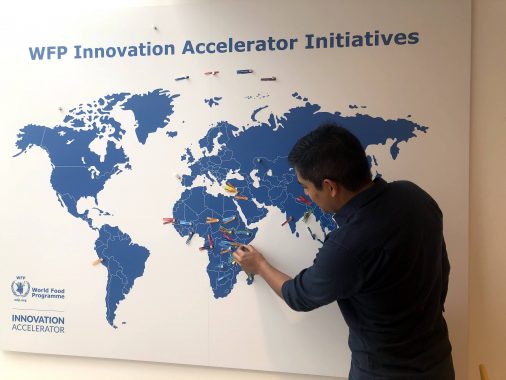
We have around 18,000 people around the world in more than 80 countries, helping in different fields to help vulnerable communities that are suffering from hunger or malnutrition because of manmade problems like conflict, war, or climate shocks.
At the innovation accelerator, we identify and support the organization’s internal or external projects to make the operations reach more people in a more efficient and faster way, or in new ways. In the end, the goal is to create a way to reach as many people as possible as fast as possible, helping to reduce the substantial number of 619 million people who are going to bed hungry every day.
For example, one of my favorite projects that we have in the accelerator is called Building Blocks. It’s a solution that is based on technology, in this case on blockchain technology to help refugees in Jordan and Bangladesh. At the moment, more than a million refugees receive cash assistance, cash transfers via a digital wallet that they can use to purchase foods at the markets and refugee camps. This may sound very normal, very mainstream to people in Europe or developing countries, but there, it was a challenge to transfer money in a complex environment where there is no infrastructure for it and it is pretty expensive.
Now with the use of this technology, they are saving time delivering the assistance they need. They are also reducing a lot of costs in bank fees or transfers. They are empowering the community and people by generating data. It is very important to know which food we need to deliver, which products, which quantities and quality, to understand them and serve them in a better way. That’s one of the projects I like that is connected to new technologies.
Another project we are working on which is not related to tech support is the Farm to Market Alliance that is currently running in Kenya and Rwanda. The goal is to support smallholder farmers, farmers with around an acre of land, to grow food for themselves and to sell the surplus to the markets. These farmers account for a high proportion of that number I gave you before, 619 million people who go to bed hungry every day. It’s ironic how it’s the farmers who are the producers of food for the rest of the world who are the ones suffering from hunger. And why? Because of market conditions, because of the way the market has been designed, or because they don’t have the right training, knowledge, techniques, tools, or inputs in the farm to make the most out of their lands.
So, what the project does is bring together different players. It’s an alliance, so they bring great players from the private and public sectors to support these farmers in the last mile. They help them with training, with better seeds. They teach them how to identify which products they need to improve in terms of productivity, storage, and how to reduce the losses and have more food, produce, and income at the end by trading it at the right place, right time, and with the right methodologies. So, ultimately, they can increase their income and improve their livelihoods and that of their families, and help them out of poverty and out of hunger.

We support this project from the accelerator through mentorship on scaling, business skills, and techniques. We also support them by connecting them with other international partners to support their costs in kind or in cash to boost their growth and reach more farmers in the region. We facilitate and bring them into creative environments to strategize and think further about their future plans. I’m personally working with them on a day-to-day basis.
I’ve learned a lot from that project. I enjoy working with the farmers and it’s interesting because this brings me back to my very first job in Peru when I was working with farmers, helping them with their business models. I’m now doing the same but on another platform. We have 12 other projects that are scaling and almost another hundred projects that have come through the accelerator to prove their idea, kill it, or build the prototype and find proof of concept, value, and then scale. That’s how we are supporting them at the moment.

Chelsea: I think it’s really important that you say we’re going to educate them, we’re going to show them how to do it, and then they can go ahead and reproduce the same kind of concepts and ideas as well as networking. I think that’s something that we take for granted a lot of the time, that it’s one thing to have the education to get started on a certain topic, but then you have the network to go ahead and come to the farming aspect. You are working with other farmers; you’re working within the markets. Really keeping that back to the trigger word is sustainability. I think that’s amazing. So, I will come to my final questions for today, which is one, where do you see the future of social entrepreneurship growing and how can someone who’s interested in social entrepreneurship get involved? What types of things and activities can they do themselves to get to where you are, for example?
Alex: I mentioned before two challenges, the low awareness and the approach to sustainability. I see this shifting in a positive or in the right direction. I see that more people are aware and willing to work in social entrepreneurship or in projects with purpose and social impact-driven on a professional level, and government and corporate level. So, we will see more companies wanting to incorporate social entrepreneurship into their strategies or giving the space to their people to work in social entrepreneurship projects. I have seen companies designing for example sabbatical programs for people who want to do social work for months and they sometimes also connect social enterprises to make this pro bono work much easier, without losing or risking their jobs back home.
You also see governments promoting and better regulating social entrepreneurship. Traditionally, we have nonprofit and for-profit companies but it’s hard to see some entity in the middle that can receive both donations and income. That’s something that the governments are still struggling to regulate and promote, but there are good examples of good practices on that.
But most importantly, I see more awareness and willingness from people. People are realizing that for example, we have 690 million people living with hunger every day. Yet we live in a world where there is enough food for everyone to eat and one-third of it is lost or wasted. Not because of a production problem, but because of distribution problems and there are many figures and examples that people are seeing and realizing that, yeah, we have to play a role here too. It’s not something that’s another person’s job or up to NGOs or not-for-profits to solve. It’s our responsibility to tackle that.
As in many other topics in life, in career, or personal growth, my advice is to follow your passions. I make it plural because it’s not one passion. We have multiple passions, and they develop, or we discover them on the way. Take the time to identify them, describe them, and visualize them. I like to draw them on a whiteboard. I used to do this too as I was learning. Especially after I came back from South Africa and after the MBA. I would draw them and see where I would find myself in a sweet spot. Then focus on three things. Get the knowledge about what social entrepreneurship is and break it down, what social means, what entrepreneurship means, and go and learn. There are many sources and platforms and cost-effective ways where you can learn and build this knowledge and skills.
The second one is network. Get immersed in the community, meet people in the field. Berlin, for example, has a very good community with organizations like the Impact Hub, MakeSense, the Social Impact Lab. Go and talk to them. That’s one of the things that I like in the sector – the community. They are really open and happy to share their journeys and experiences. From that, you will learn what social entrepreneurs do. I’m sure that you will find out that it’s something that you have been doing for a while without knowing it. That happened to me. It will help you connect and find opportunities where you can join their community.
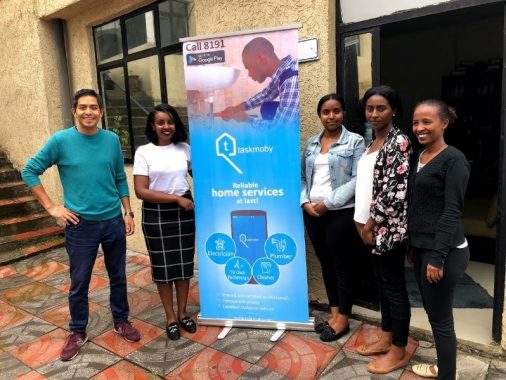
Third, and maybe it’s one of the most important, get exposure and get your hands dirty. For example, volunteering or offering yourself for pro bono consulting. Or even just volunteer for specific projects to support organizations and not only one, try different ones. You can learn by doing what you like the most, what sparks your happiness, your passions, and also where you can add value. In my case, it was the business mindset, the business and financial approach to social impact where I saw that I can add more value. This will bring you back to the beginning, to the passions. As you get your hands dirty and get immersed in the community and learn the skills, you will validate, confirm, or maybe find new passions. That’s what I always share with people about what worked in my case to arrive at this stage where I enjoy every day what I do.
Chelsea: That is a great ending statement. I want to thank you again Alex for an interesting and engaging discussion today and thank our viewers for engaging with EMT Berlin’s Alumni Webinar Series. So, until next time, please stay safe and healthy. Thank you.
This transcript has been edited for clarity.
